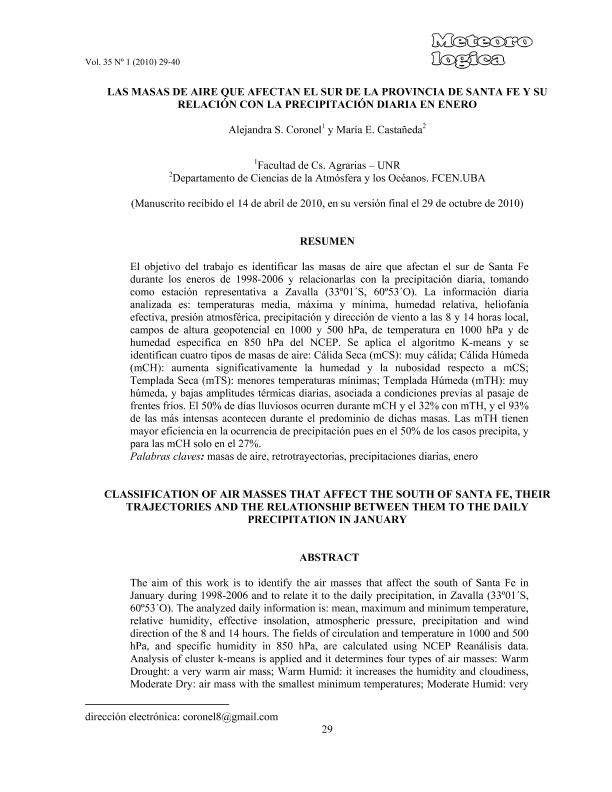Artículo
El objetivo del trabajo es identificar las masas de aire que afectan el sur de Santa Fe durante los eneros de 1998-2006 y relacionarlas con la precipitación diaria, tomando como estación representativa a Zavalla (33º01´S, 60º53´O). La información diaria analizada es: temperaturas media, máxima y mínima, humedad relativa, heliofanía efectiva, presión atmosférica, precipitación y dirección de viento a las 8 y 14 horas local, campos de altura geopotencial en 1000 y 500 hPa, de temperatura en 1000 hPa y de humedad específica en 850 hPa del NCEP. Se aplica el algoritmo K-means y se identifican cuatro tipos de masas de aire: Cálida Seca (mCS): muy cálida; Cálida Húmeda (mCH): aumenta significativamente la humedad y la nubosidad respecto a mCS; Templada Seca (mTS): menores temperaturas mínimas; Templada Húmeda (mTH): muy húmeda, y bajas amplitudes térmicas diarias, asociada a condiciones previas al pasaje de frentes fríos. El 50% de días lluviosos ocurren durante mCH y el 32% con mTH, y el 93% de las más intensas acontecen durante el predominio de dichas masas. Las mTH tienen mayor eficiencia en la ocurrencia de precipitación pues en el 50% de los casos precipita, y para las mCH solo en el 27%. The aim of this work is to identify the air masses that affect the south of Santa Fe in January during 1998-2006 and to relate it to the daily precipitation, in Zavalla (33º01´S, 60º53´O). The analyzed daily information is: mean, maximum and minimum temperature, relative humidity, effective insolation, atmospheric pressure, precipitation and wind direction of the 8 and 14 hours. The fields of circulation and temperature in 1000 and 500 hPa, and specific humidity in 850 hPa, are calculated using NCEP Reanálisis data. Analysis of cluster k-means is applied and it determines four types of air masses: Warm Drought: a very warm air mass; Warm Humid: it increases the humidity and cloudiness, Moderate Dry: air mass with the smallest minimum temperatures; Moderate Humid: very humid air mass, daily losses thermal amplitude, associated to the previous conditions to the passage of cold fronts. The 50% of the precipitation days happen during Warm Humid masses and the 32% with Moderate Humid, and 93% of the most intense occurs during these masses. Moderate Humid have major efficiency in the precipitation occurrence because in 50% of the cases precipitates, and for Warm Humid only in 27%.
Las masas de aire que afectan el sur de la provincia de Santa Fe y su relación con la precipitación diaria en enero
Título:
Classification of air masses that affect the south of Santa Fe, their trajectories and the relationship between them to the the daily precipitation in January
Fecha de publicación:
06/2010
Editorial:
Centro Argentino de Meteorólogos
Revista:
Meteorológica
ISSN:
0325-187X
e-ISSN:
1850-468X
Idioma:
Español
Tipo de recurso:
Artículo publicado
Clasificación temática:
Resumen
Palabras clave:
Masas de Aire
,
Retrotrayectorias
,
Precipitaciones Diarias
,
Verano
Archivos asociados
Licencia
Identificadores
Colecciones
Articulos(OCA CIUDAD UNIVERSITARIA)
Articulos de OFICINA DE COORDINACION ADMINISTRATIVA CIUDAD UNIVERSITARIA
Articulos de OFICINA DE COORDINACION ADMINISTRATIVA CIUDAD UNIVERSITARIA
Citación
Coronel, Alejandra S.; Castañeda, Maria Elizabeth; Las masas de aire que afectan el sur de la provincia de Santa Fe y su relación con la precipitación diaria en enero; Centro Argentino de Meteorólogos; Meteorológica; 35; 1; 6-2010; 29-40
Compartir




